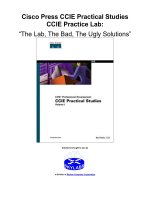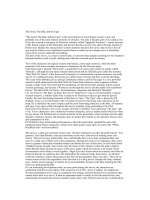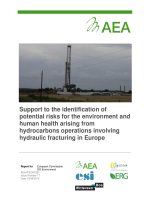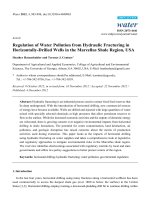Hydraulic fracturing the good, the bad, and the ugly
Bạn đang xem bản rút gọn của tài liệu. Xem và tải ngay bản đầy đủ của tài liệu tại đây (7.01 MB, 34 trang )
Hydraulic Fracturing:
The Good, The Bad, and the Ugly
Stephan MacLellan, P.Eng
SPE Luncheon
November 21, 2012
The Good, The Bad, and the Ugly
– an unbiased view of Hydraulic
Fracturing
THE GOOD
Increases Energy Production
Regulated (ERCB is a world leader)
Creates lots of good jobs
If done correctly, it can be a very environmentally friendly way to produce energy –
What the Frac?
THE BAD
Current Slickwater/Freshwater treatments are not
sustainable in dry or water depleted environments
REALLY, It’s not that bad
Water and Air contamination
– tells a different
story than GasLand. Which one is true?
The UGLY
• The Bad Press and Lack of Transparency
• Pumping at high pressures – safety must be enforced
and followed!
Presentation Outline
What is Hydraulic Fracturing (aka Fracin’, Fracking, Stimulation)?
The Oil and Gas Well Development Process
Types of Fracture Treatments
Myths and Truths of Hydraulic Fracturing
A quick comparison with other sources of energy production
The future of Hydraulic Fracturing
Question period
What is Hydraulic Fracturing
aka Fracin’, Fracking, Stimulation?
Engineer’s Definition: is the process of transmitting pressure by fluid or gas
to create cracks or to open existing cracks in underground rock. These cracks
are then usually filled with sand to produce a more permeable pathway for oil
and gas to travel to the wellbore.
1947 Standard oil – first treatment – Kansas (Commercial by 1950)
Over 175,000 wells in Western Canada hydraulically fractured, over a million worldwide
Currently over 60% of all wells completed in this manner
Can increase production up to x1000
Public’s Definition: Fracturing has come to represent nearly every phase of the
well development cycle from drilling to production
Oil and Gas Process
Step 1 – Geology
Step 2 – Seismic Recording
Step 3 – Pad Construction
Step 4 – Drill the well
- Surface Casing
- Production Casing
Step 5 – Cement the Wellbore
Step 6 – Run logs (Bond logs)
Step 7 – Frac (60% of wells)
Step 8 – Lease clean up
Step 9 – Production - tie into pipe
line or tanks
The most important step
Cementing the wellbore!!
Ensure total Isolation
Casing should be cemented from total vertical
depth to surface – Always practiced in Canada,
sometimes in USA
Surface Casing is placed below water table
Leak tests and bubble tests (GM and SCVF)
-If a micro annular leak occurs, it can be fixed!
Fracturing occurs after the vertical part of the
well has been drilled, cased and cemented.
Types of Fracture Treatments
1. Hydrocarbon Fracs - Frac Oil, Propane and soon Liquid
Natural Gas Fracs
No water used
3 additional chemicals: Activator (Ferric sulphate), Gellant (Phosphorus
Acid) and Breaker (Magnesium oxide)
Flowback can be 100% reused, recycled or sent to production
Cost of product can be retrieved if set up properly
Increased risk of fire or spill – Extra Safety precautions needed
Types of Fracture Treatments
2. Foam Fracs
70-95% CO2 or N2
30-5% water
CO2 and N2 is
taken from the atmosphere
(greenhouse friendly)
Gellant, surfactant,
Breaker used
Expensive and not as robust (viscous) as Frac oil or crosslinked water
100% N2 is often used for Coal Bed Methane Fracs
Types of Fracture Treatments
3. Crosslinked Water Fracs
Water used (very viscous and robust)
Gellant, Crosslinker, Surfactant, Clay Control, Breaker
Used for 85% of conventional wells that are fractured
Types of Fracture Treatments
4. Slick Water Fracs
Recently in the media
Used for tight gas and shale gas
(unconventional rock)
Friction Reducer only chemical
needed*
Little to no viscosity,
fast pump rates,
lower sand concentrations and
larger volumes of water needed.
* Several Studies show that extra chemical actually decreases production, Economides
•Shale Oil and Gas represents ~ 1% of total water use in the USA (Golder Associates)
•15.9 MM m3 water used in Alberta in 2011 (CAPP)
•0.6 barrel of fresh water is used to produce 1 barrel of Oil in Alberta (Rudy Tamayo)
•There has been an 854% increase in proppant use over the last 5 years in North
America (Chris McCullough, Fracknowledge)
SOLUTIONS TO WATER USAGE:
Engineering Optimum Fracs
Information Age – Service data bases, Accumap, FracKnowledge, etc.
N2 and CO2 assists
Re-use and/or recycle frac fluid
Use of produced and sourced salt water
Why frac? Why Now?
The
Unconventional
has now
become
Conventional!
Fracking Allegations – however, several studies and articles*
clearly discusses the issues and concludes fracturing is safe
Fracturing process contaminates drinking water - False
Fracturing uses “toxic soup” of chemicals – False, but there is
room for improvement
Fracturing causes cancer ???? – IT DOES NOT
Fracturing will decrease tourism and land value - False
Fracturing causes earthquakes – True
Shale exploration is unregulated - False
Oil companies are beating down the door to frac at any cost -
False
The Public is 100% against oil companies and fracturing -
False
* Popular Mechanics, Time, New York Times, National Research Council, ESG, PNAS, EPA
Frackin’ Allegations
Frackin’ Allegations
Public Concerns
•Water Usage
•Truck Traffic
•Road construction
– No Spider Webs
•Air and water contamination
•Life span of wells
•Lack of Transparency!
Why the Bad Rep?
What can we do about it?
Photo courtesy of Audrey Mascarenhas, Questor Technology INC
Let’s Frac
Ground water is usually <100m
Fracture treatments are generally
1000m-4000m TVD
Frac height =30m - 100m
Frac width = 1mm - 3mm
Frac length = 100-800m
With proper well construction, shallow
groundwater aquifers are protected from
fracturing fluids and hydrocarbons in the well
bore using cement and steel casing – CEMENT
JOB IS VIP
ERCB just concluded that 23 well bore
communications happened since 2009. – All
within the same zone! (frac height is contained)
Ground Water Contamination
“There are 0 incidents of ground
and water contamination due to
Hydraulic Fracturing”*
* Almost all contamination is due to the lined pits, which are not used in Canada. Spills and poor
or improper cement account for a small number contamination
-This does not and can not happen! 3
stresses: 1 vertical, 2 Horizontal,
Vertical stress will always be greatest
“The potential for chemical contamination of underground or surface sources of
fresh water during all phases of well development comes exclusively from: Road
transport of components or fuel, onsite storage and surface mixing of fluids” –
George King, SPE 152596
“Fire from tap was naturally occurring”
COGCC
Poisoned fish in Gasland did not happen
from fracin’!!
Often Closed system (no open pits)
No spill regulation
Lease is cleaned with vacuum truck
Lease can be restored to natural
environment
Produced fluid can be reused, treated or
disposed in a disposal well
Let’s get back to the frac
It’s Not “Toxic Soup”
“Gasland” mentions that over 750 chemicals are
used during the fracturing process – can be 1 - 10
additives.
Frac jobs are 99.5% water (or HC) and Sand
Slick water fracs need 1 – 2 additives: FR (Biocide
should be added if surface water is used)
Biocides, Surfactants, Clay Control and Acid are sometimes
added (depended on the formation, completion type and salesman)
Most additives are
environmentally friendly
or
can be!
WHAT’S ENVIRONMENTAL
FRIENDLY??
HOW DOES ONE PRODUCT COMPARE WITH ANOTHER??
Encana is using a third party called Intrinsik to test toxicity of
chemicals used
OTHER MODELS INCLUDE:
CHARM MODEL, WHIMIS
SCJRS, SmartCare, Multichem – Naturaline products
Are results
open to the public?
www.fracfocus.ca
Frac Fluid Additives
Ingredient Common Name Frac Fluid use Common use
Gellant
Guar bean gum
Water viscosifier, forms gel to
suspend sand
Thickener used in cosmetics,
toothpaste, and sauces
Gellant
Cellulose polymer
Water viscosifier (thickener) to
suspend sand
Thickener for cosmetics and
household products.
Crosslinker
Borate salt
Increases gel viscosity Used in laundry detergents,
hand soaps and cosmetics
Gel Breaker
Sodium borate salt
Gel breaker to lower viscosity for
efficient cleanup
Laundry detergent and
pharmaceuticals
Gel Breaker
Cellulase/Hemicellulase
Gel breaker (enzyme) to lower
viscosity for efficient cleanup
Used in commercial food
processing, laundry detergents,
and pharmaceuticals.
Friction Reducer
Polyacrylamide
Minimizes friction between fluid
and pipe
Flocculant for water treatment,
soil conditioner for farming
Clay Control
Chlorine compound
To prevent clay swelling when
contacted by water
Additive for feed/farming
Flowback
Enhancer
Surfactants
Promotes the return of fluid from
the formation to the wellbore
Cosmetics
Scale Inhibitor
Phosphonate
Prevents scale from forming on
pipes
Pharmaceuticals, water
treatment, desalination
systems.
pH Control
Sodium or potassium carbonate
Maintains effectiveness of gel
crosslinker
Used in washing soda, soap,
hot tubs and water softeners
Carrier Fluid
Mineral oil
Carrier fluid for powdered
additives
Cosmetics, pharmaceuticals,
lubrication electric components
Bactericide
DBNPA (amide)
Kills bacteria in mix water Cooling tower treatment
Pre-Frac well
treatment
Hydrochloric Acid
Cleans and dissolves scale Cleaner (muriatic acid),
stomach acid
Carrier Fluid
Antifreeze
Propylene Glycol
Freeze proofing of water based
carrier fluids
Pharmaceuticals (cough syrup),
food processing
It’s not “Toxic Soup”
A generic Slick Water Frac uses 400m3 to 1000m3 of water
per stage.
A horizontal well averages 15 stages
1000m3 *15 = 15,000m3 of water
Friction reducer is added at .4 to 1 litre/m3
15m3 or 15,000 litres of FR per well!
Make sure the additives used are non-toxic!
How Does FR and other Frac
Chemicals Score?
Product Classification:
Category A: No Further Action Required
Category B: Practices and/or Controls Required
Category C: Further Review Required
Do Not Use List
Completion has: Category A – 28% products
Category B – 50% products
Category C – 3% products
42 Unknowns (18%)
Transparency is needed
* Due to recent testing, service companies have stopped using
several Category C chemicals. A renewed focus on developing
greener products has develped
What about the earthquakes?
Earthquakes
Seismic activity potentially resulting from
fracturing measures less than 3.5 on the
Richter scale
Horn River, B.C. (2.5-3.5)
Blackpool, England (1.5-2.3)
Seismic activity is contained in a small area
Richter Scale (worldwide):
2 or less 8,000 / day Not felt
2 – 2.9 1,000 / day Not felt, recorded
3 – 3.9 49,000 / year Often felt, rarely causes damage
Each level is 10 x stronger than the previous level
Earthquakes in the news have 10,000 more energy
“none of the events cause any injury, property damage or posed any risk to public
safety or the environment” BC Oil and Gas Commission Study concluded after recording 272
seismic events from April 2009 and December 2011 (approx 8000 treatments), (August30, 2012)









